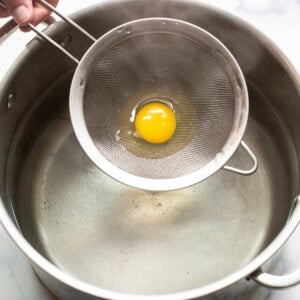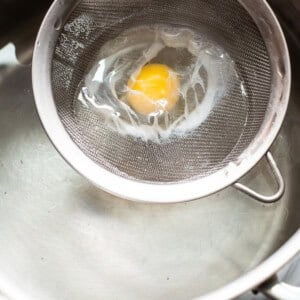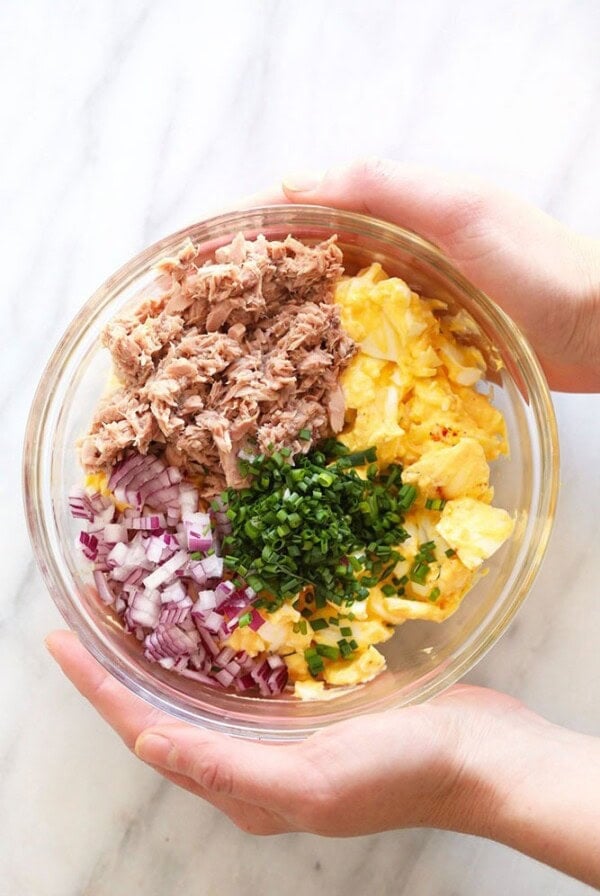Perfect Poached Eggs
Published 11/27/2022
This post may contain affiliate links. Please read our disclosure policy.
Looking for the BEST poached eggs recipe? This simple method will give you the perfectly firm egg whites and an oozy, golden yolk you’ve been dreaming of, even if you’re a beginner!
With a few tips and a little practice, you’ll have a delicious, perfectly poached egg in no time.

The Perfect Poached Eggs
Poaching eggs can seem quite intimidating to some. Whether it’s getting just the right amount of vinegar in your water or nailing down that flawless whirlpool motion, it can take a few tries to get your poached eggs looking and tasting just right.
Luckily, we’ve done all the trial and error for you so you can skip ahead to the good part: cooking and eating an effortlessly tasty poached egg.
why you’ll love it
Our step-by-step instructions mean you’ll have perfectly cooked poached eggs every single time 😀
We’re talkin’ jammy yolks and firm egg whites.
We’re sharing perfect recipe pairings to round out your delicious breakfast.
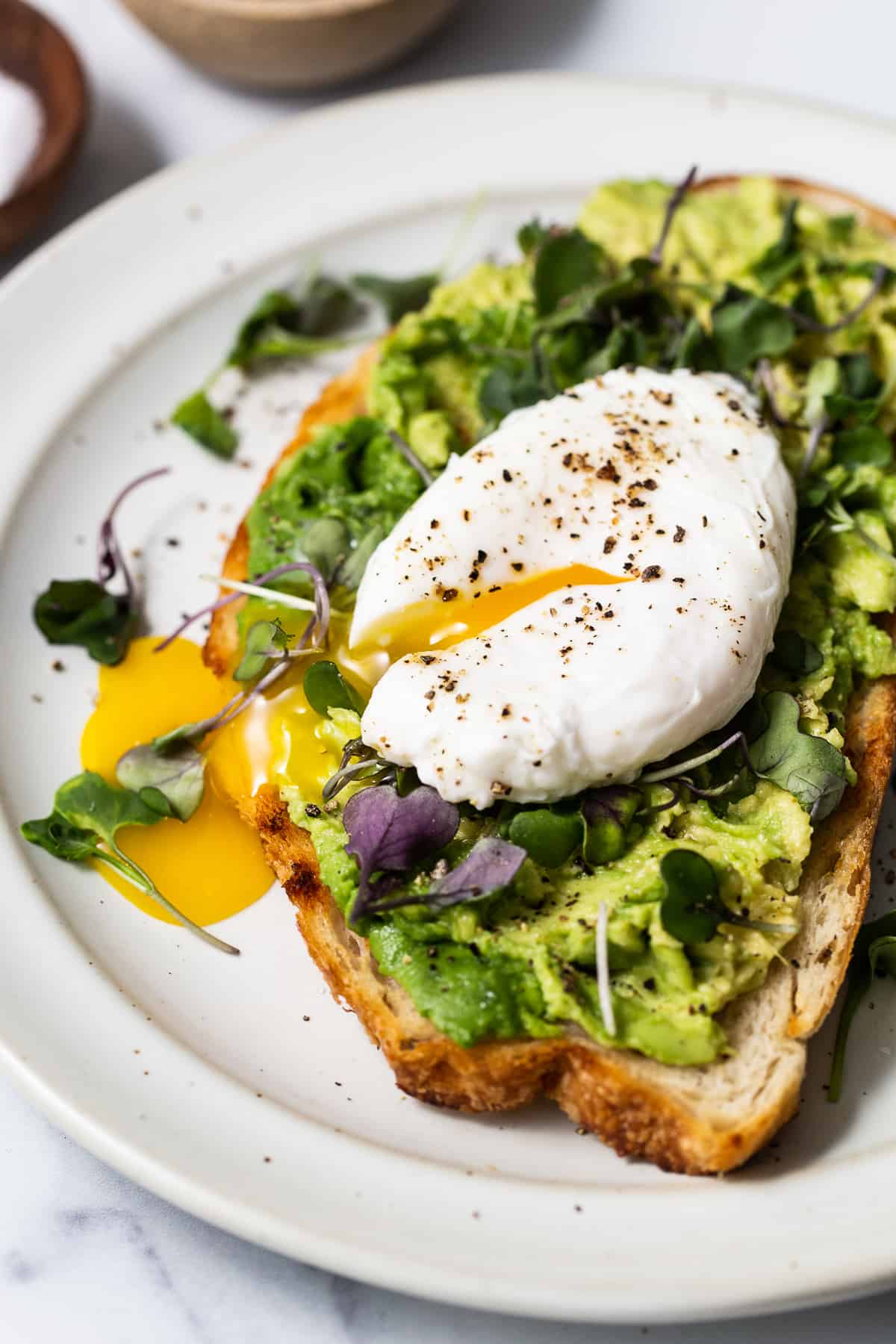
A poached egg is an egg that has been dropped from its shell and strained of its egg whites to then get cooked in simmering water for about 5 minutes. It’s the best method for cooking eggs, without losing any moisture or nutrients!
What is the point of poached eggs?
There’s a lot to love about poached eggs besides the pure satisfaction of an oozy egg encased in fluffy egg whites. In fact, one of the greatest benefits of poaching your eggs is that there’s no added fat required.
Frying your egg in a pan requires butter or oil, but not with a poached egg! They are cooked directly in water to make a delicious, low-calorie alternative.
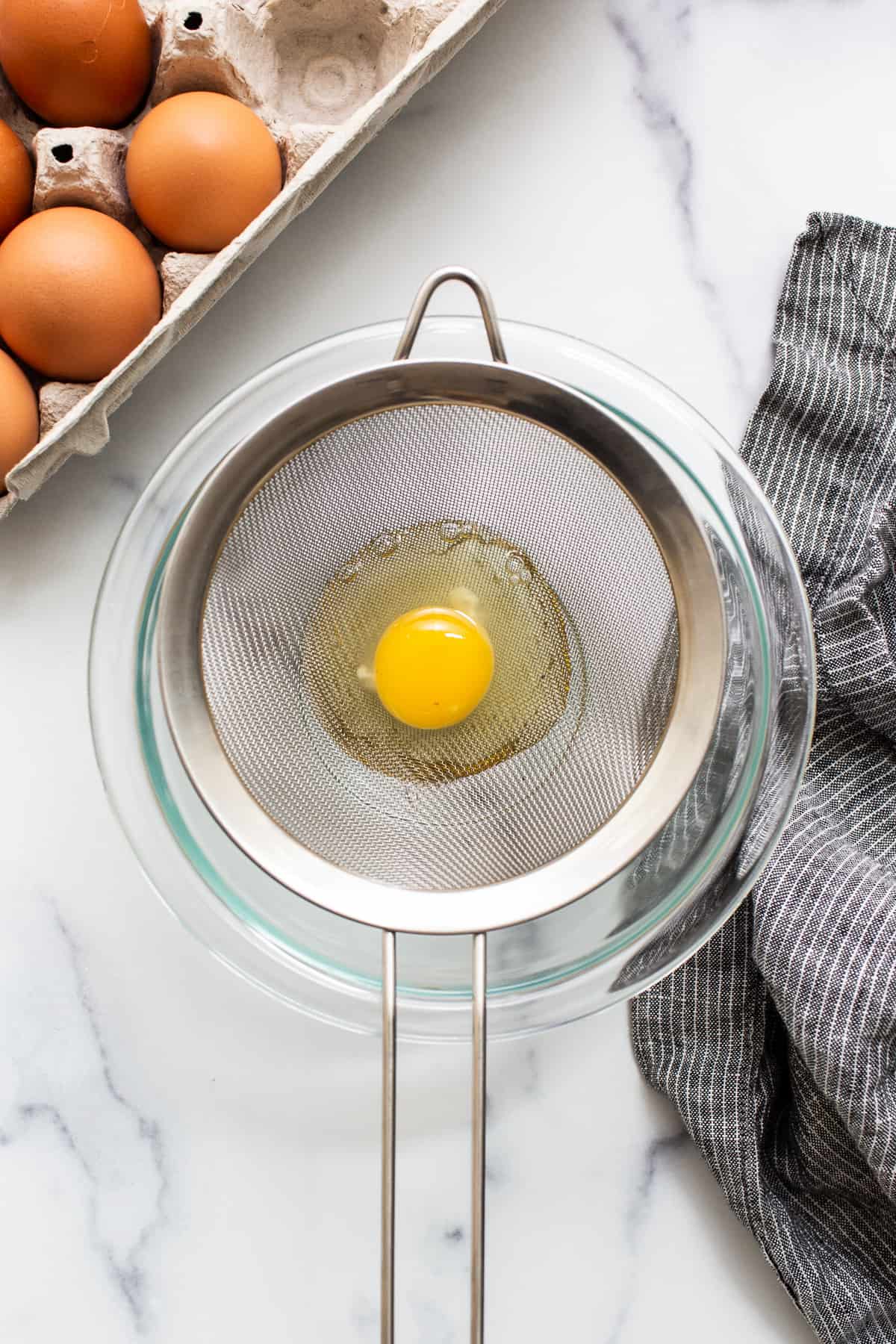
What You Need for Poached Eggs
Many assume that something as seemingly gourmet as a poached egg would require a lot of equipment. However, all that you need to make the perfect poached egg is:
- 1 pot of water
- 1 fine mesh strainer
- 1 bowl
- 1 spoon
If you have an egg poaching cup, even better! But you’ll be just as fine without one.
How to Make a Poached Egg
BOIL WATER
First, bring a large pot of salted water to a boil. Once boiling, turn the heat down to the lowest setting.
STRAIN EGG WHITES
Next, get your fine mesh strainer and place it over a small bowl. Coat the mesh with a little olive oil and crack your egg into the strainer until all of the excess egg white strains into the bowl.
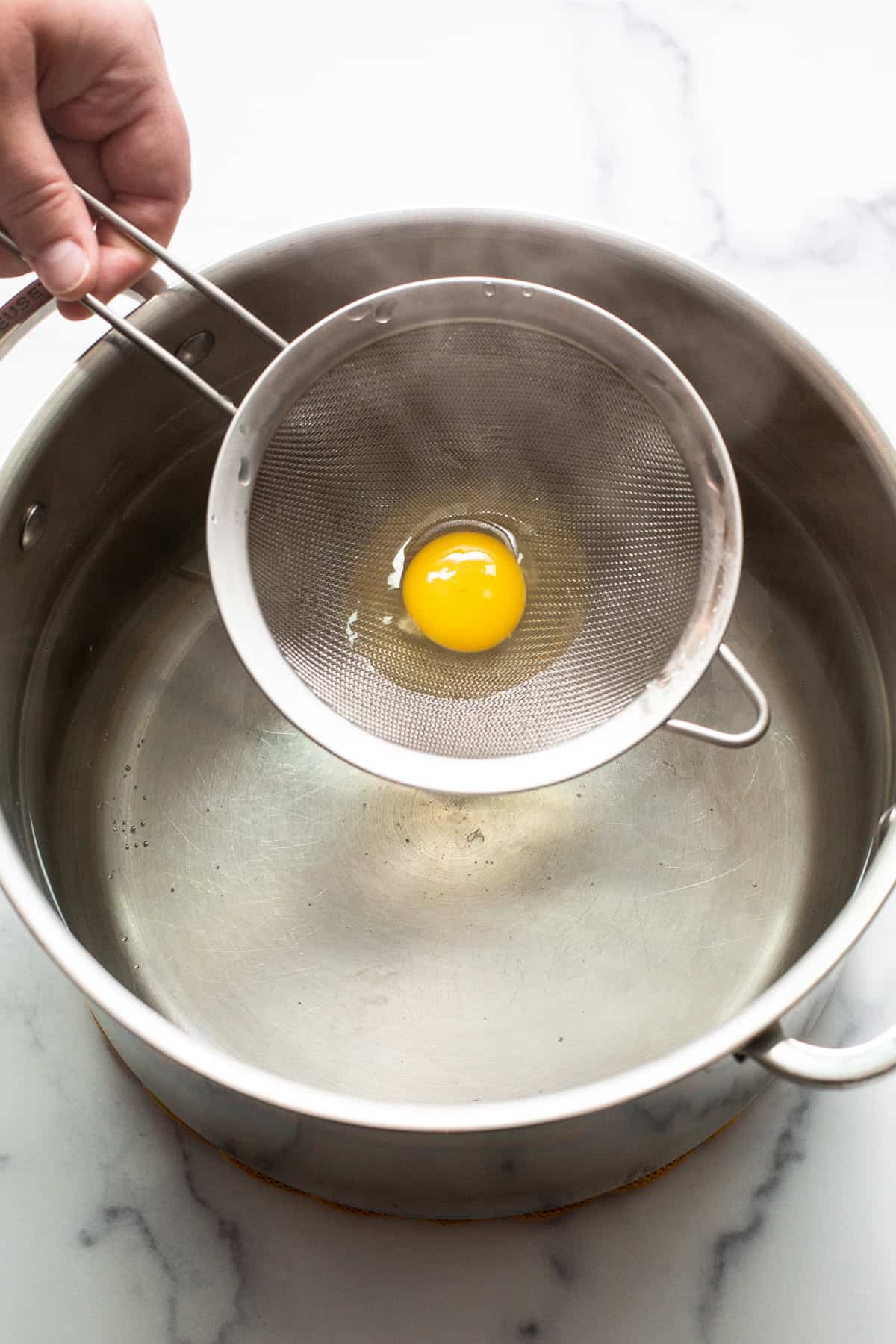
ADD THE EGG & COOK
Carefully place the entire mesh strainer, with the egg, into the simmering water. Allow the egg white to cook a little before gently tipping the strainer into the water to fold over the egg yolk.
STIR WATER
Last but not least, it’s whirlpool time!
Gently stir the water with a spoon so the egg moves with the swirling water. After a few moments, stop stirring. Once the egg starts slowing down, give it another little stir and let the egg poach for about 3-4 minutes. You can wait longer if you’d like a harder yolk.
Repeat with the remaining eggs, and serve. Congrats! You are officially an egg poaching master.
Make-Ahead Poached Eggs
Making a big batch of poached eggs is quite simple. Whether you’re serving them for a crowd or even just as meal prep for yourself, this easy method will have your eggs just as fresh and unscathed as the day you made them.
- After you’ve made your poached eggs, *immediately* transfer them to a bowl of cold water for an ice water bath. You may top off the bowl with more cold water if needed until the eggs are cool.
- Once cooled, carefully transfer your eggs to an airtight container and refrigerate for up to 5 days before serving.
- To reheat your eggs, transfer them to a bowl of hot water for 2 to 3 minutes. Don’t place them in boiling water, as your eggs may overcook. Make sure there is enough water on top to fully heat the eggs.
- When it’s time to serve, gently scoop them out of your water with a slotted spoon. Pat them dry with a paper towel and serve!

Top Tips
Use fresh eggs: Eggs are always better fresh, be sure to check the date on your eggs before poaching them.
Don’t skip the strainer: This recipe was tested with and without a fine mesh strainer and the strainer made all the difference.
Cook time will vary: We tested this recipe with medium eggs and large eggs. The cook time varied by egg size.
FAQs
How long you poach your egg really depends on how hard or soft you like them.
For instance, a really soft and runny poached egg should take around 2 minutes to poach, while an egg that is a bit firmer (but still a little runny) should take about 4 minutes. If you want a firmer egg with a more solidified egg yolk, wait a couple of minutes longer.
The best way to check the doneness of your egg is by carefully removing it from the pan using a slotted spoon and giving it a gentle prod with a teaspoon.
Vinegar is not necessary for poaching an egg, but many prefer to use it. If you don’t have vinegar, substituting it with lemon juice works just as well! The acidity of lemon serves the same purpose as vinegar when poaching eggs.
Adding a bit of vinegar to your boiling water will help increase the rate of denaturing, allowing your poached egg to hold its shape better. Vinegar has a high level of acidity, which is a key element for tighter whites.
Yes! To poach two eggs at a time, crack your eggs into the same mesh strainer. Then gently tip them into the water and, without stirring, allow the eggs to cook for 3 to 4 minutes or until desired hardness.
The temperature of your water makes all the difference when making poached eggs!
If the water isn’t hot enough, the eggs will dissolve in the water before they set, giving you a pot of milky water. If the water is too hot from too rapid of a boil, the eggs will jiggle around and cause the whites to disintegrate, creating those pesky little white whispies.

What to Serve with Poached Eggs
- Bacon
- Maple Breakfast Sausage
- Sheet Pan French Toast
- Cinnamon Roll Waffles
- Banana Oatmeal Pancakes
- Greek Yogurt and Steel Cut Oatmeal Parfait
- Blueberry Orange Granola + Yogurt
- Healthy Smoothies
Storage
Store your poached eggs by carefully removing each egg from the water with a slotted spoon. Quickly and carefully place them in a bowl of icy water to stop your eggs from cooking, breaking, or sticking. Then simply place your bowl of eggs in the fridge until ready to eat!
To reheat: Reheat eggs on low in the microwave to be sure you don’t over cook them.
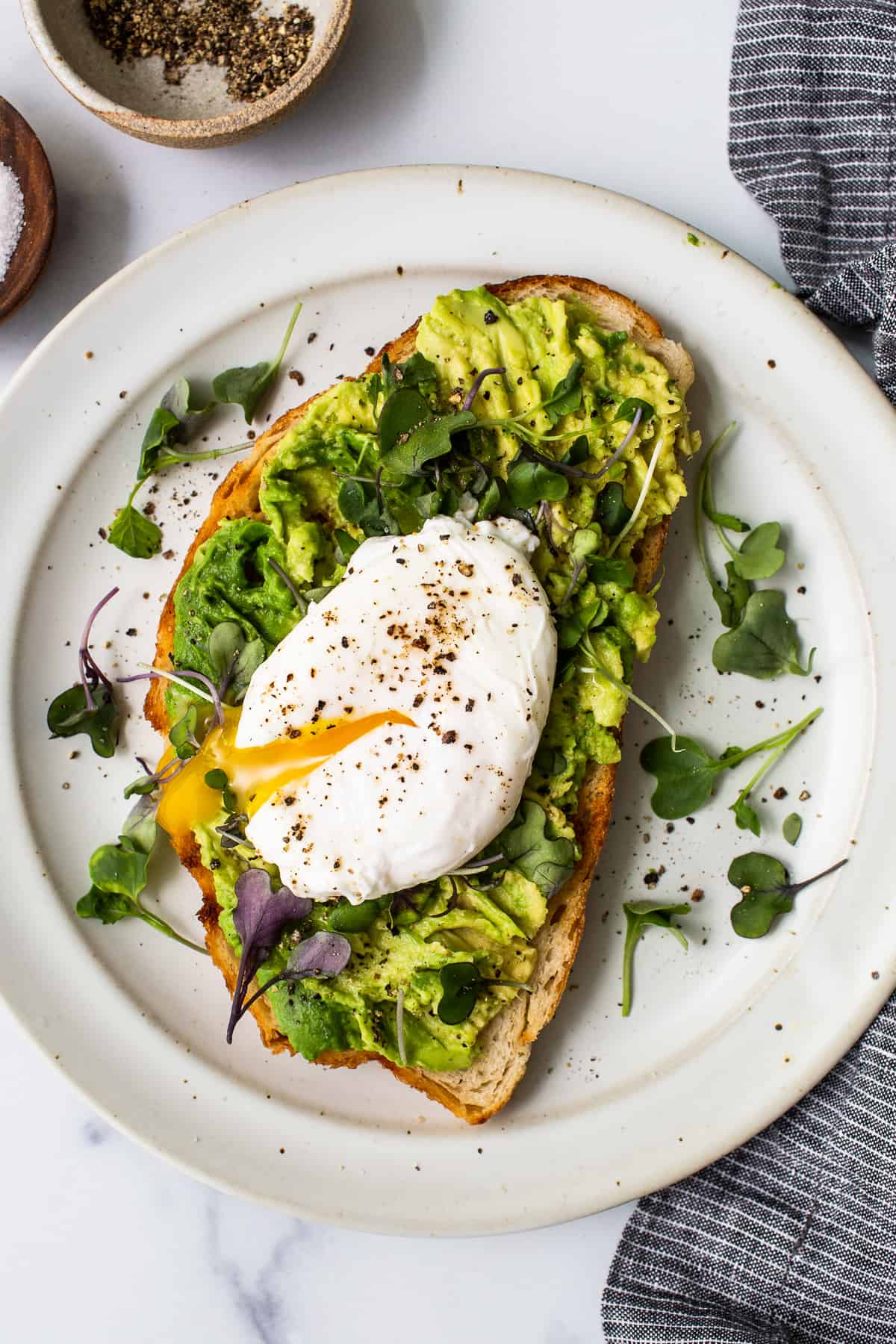
Perfect Poached Eggs
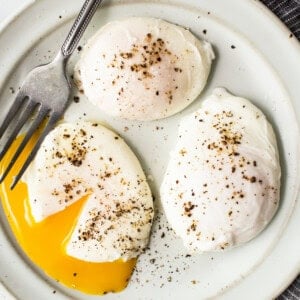
Ingredients
- 4 large eggs*
Instructions
- Bring a large pot of salted water to a boil over high heat and then turn the heat to its lowest setting.
- Next, place a fine mesh strainer over a bowl and coat the strainer with a bit of olive oil. Carefully crack an egg into the strainer. Allow the excess egg white to strain into the bowl.
- Carefully place the whole mesh strainer with the egg inside in the simmering water and allow the egg white to begin to cook and then gently tip the strainer into the simmering water. The egg white should have folded over the egg yolk.
- Gently stir the water so the egg slowly moves as it cooks. Let the egg poach for 3-4 minutes. The longer you poach the egg, the harder the yolk will be.
- Repeat with the remaining eggs.
Tips & Notes
- Fresh eggs tend to work best for poached eggs.
- *We tested this recipe with medium eggs and large eggs. The cook time varied by egg size.
- This recipe was tested with and without a fine mesh strainer and the strainer made all the difference.
Watch It
Nutrition
Nutrition information is automatically calculated, so should only be used as an approximation.
Don’t forget to tag your posts on social media with the hashtag #fitfoodiefinds, we’d love to see what you’re up to!
Photography: photos taken in this post are by Ashley McGlaughlin from The Edible Perspective.
